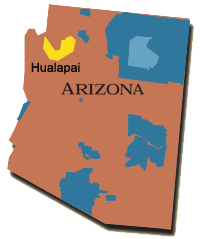Reservations
Arizona: Hualapai
 |
"In 1867, the Band of Indians consisted of over 1500 people, between 400 and 500 fighting men; they were a wild, capable, implacable foe...They were relentlessly pursued by me for two years, and in 1869, surrendered and asked for peace; several of their prominent men were sent to San Francisco in irons and remained for months as prisoners on Alcatraz and Angel Islands...They were thoroughly subdued, and...sent to the Colorado River Reservation; being Mountain Indians they died there very rapidly; they sent word to General (George) Crook that they did not want to fight, but that they could not live there, that they would rather die fighting on their native mountains than sicken and die as they were doing on the river bottom." Lieutenant Colonel William Price, United States Army
AncestryThe Hualapai (sometimes spelled Walapai) descended from the Hohokam culture and were called the "pine tree folk." It is estimated that there were 700 Hualapai in 1680.
With the Yavapai and Havasupai, the Hualapai have occupied North Central Arizona for nearly eight hundred years. There are many similarities to the Yuman dialect that all three peoples use.
The Hualapai roamed over a large area north of the Mohave Desert to the Grand Canyon. Once they acquired horses from the Spanish they were able to extend their range.
These tribes subsisted primarily as hunting and gathering communities. They acquired some knowledge of agriculture and cultivated gardens but were not considered successful agronomists.
The Hualapai didn’t have much contact with western civilization until the 1840s when trappers and prospectors moved into their territory. The Hualapai initially resisted but realized it was in their best interest to accommodate the intruders. Miners used them as a source of cheap labor and white ranchers moved in and took over most of their territory.